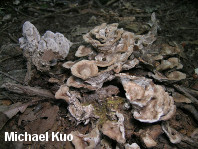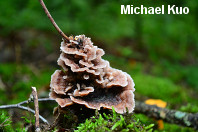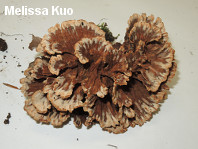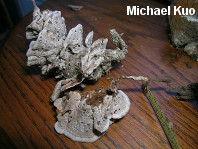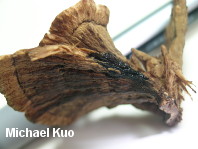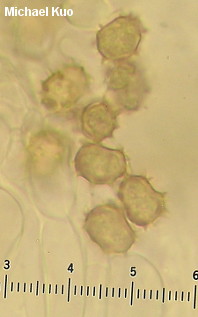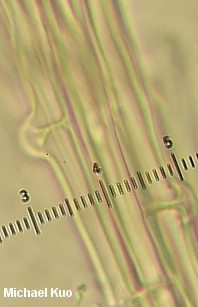| Major Groups > Crust Fungi > Thelephora americana |

|
Thelephora americana [ Basidiomycota > Thelephorales > Thelephoraceae > Thelephora ... ] by Michael Kuo Thelephora americana is a hardwood-associated, terrestrial, spreading fungus that grows quickly, forming caps in clusters and rosettes, and swallowing up forest litter in the process. It is similar to the better-known Thelephora terrestris, but differs in its paler colors, smaller spores, and association with hardwoods; Thelephora terrestris is found in conifer forests. Thelephora vialis is also similar, but features cap clusters that share a more clearly defined stem structure, along with very different spores that lack true spines. Erudite taxonomic note for the day: it is unclear whether the name "Thelephora americana" is legitimately applied to the mushroom featured here, first described in 1915 by Lloyd and later emended by Corner (1968). Both Index Fungorum and MycoBank list the combination "Thelephora americana (Peck) Sacc.," from 1902, representing a mushroom originally called "Thelephora palmata var. americana" by Peck and now known as Thelephora anthocephala, as having priority. But the publication cited by both taxonomic databanks (Saccardo, 1902) does not actually elevate Peck's variety to species level; instead, it reiterates Peck's "Thelephora palmata var. americana." Description: Ecology: Mycorrhizal with oaks and other hardwoods; spreading terrestrially and forming clustered fruiting bodies; summer and fall; widely distributed in North America east of the Rocky Mountains. The illustrated and described collections are from Illinois and Ohio. Fruiting Body: A spreading mass of cap-like structures 2-5 cm high, often fused laterally and/or forming rosettes; often engulfing twigs, leaves, and small branches. Caps: 2-6 cm across; centrally depressed; irregular, but usually fan-shaped to semicircular; becoming radially wrinkled; dry; fibrillose to velvety; in old age sometimes breaking up into scales; grayish brown, with a paler, hairy margin when fresh; vaguely zoned. Undersurfaces: Smooth when young, becoming wrinkled or, in old age, developing a slightly pimpled surface; pale gray, becoming grayish brown; bruising darker brown when mature; bald. Flesh: Tough; 2-4 mm thick; pinkish brown to rusty brown; unchanging when sliced. Odor: Not distinctive. Chemical Reactions: KOH grayish to black on all surfaces and flesh. Spore Print: I have not documented the spore print; probably brown. Microscopic Features: Spores 6-9 x 5-6.5 µ (excluding ornamentation); irregular and angular; covered with spines that extend 0.5-1.5 µ; golden to brownish in KOH. Basidia 2- to 4-sterigmate; to about 65 x 12 µ. Subhymenium not bluing in KOH. Tramal hyphae cylindric; 4-6 µ wide; thick-walled, smooth, and brownish to brown in KOH; often clamped at septa. REFERENCES: Lloyd, 1915. (Corner, 1968; Stalpers, 1993.) Herb. Kuo 09250803, 07021301, 07181508. This site contains no information about the edibility or toxicity of mushrooms. |
© MushroomExpert.Com |
|
Cite this page as: Kuo, M. (2015, December). Thelephora americana. Retrieved from the MushroomExpert.Com Web site: http://www.mushroomexpert.com/thelephora_americana.html |
